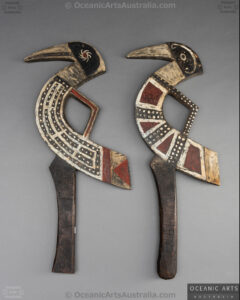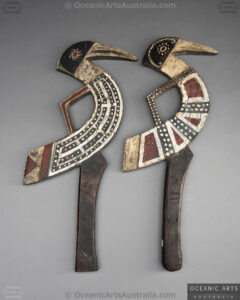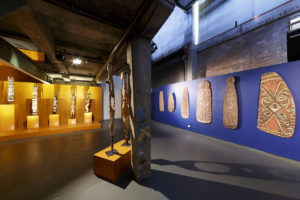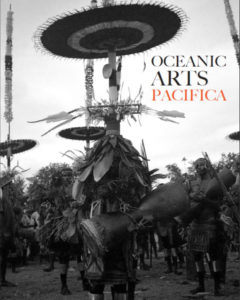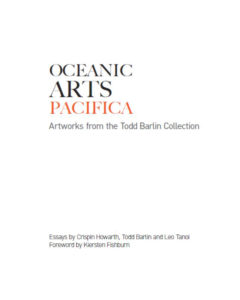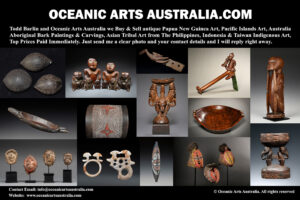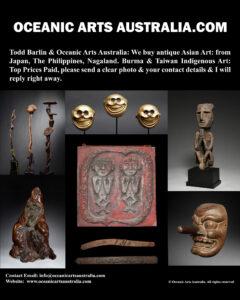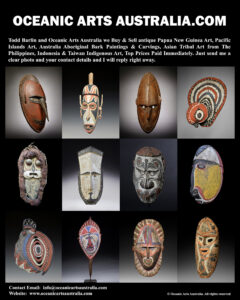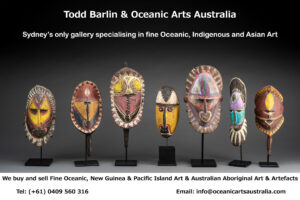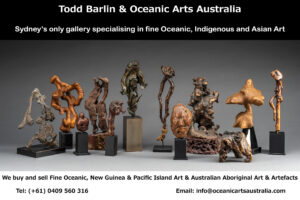Two Fine Old Solomon Islands Dance Birds Malaita Island Solomon Islands
| Collection No. | TB-2314 |
|---|---|
| Size | Height 50cm |
Two Fine Old Solomon Islands Dance Birds Malaita Island Solomon Islands
These two fine old and used Dance Wands are from the Kwara’ae people of North Malaita Island in the Solomon Islands.
Carved in the form of a stylized bird which is a clan totem. When groups of ceremonial dancers use these Dance Wand Birds they are accompanied by music made from bamboo Pan Pipes. The dances re-enact the mythology of the voyages made by the original ancestor to arrive at North Malaita where the Kwara’ae people live today.
Birds motifs are often used in Solomon Islands art, frigate birds are very important to the lives of Solomon Islanders. When watching the sea they can see when frigate birds are hunting small baitfish by circling and diving in the water. Where there are small baitfish large Tuna follow. Tuna is one of the most important fish for food in the Solomon Islands.
Crispin Howarth at The National Gallery of Australia in his superb publication & exhibition at the NGA VARILAKU: Pacific Islands Art from the Solomon Islands 2011 states
” Large sculptures of bonito fish (Katsuwonus pelamis) hung from the rafters inside ceremonial canoe-houses along with carvings of sharks and people, and trophies of fish skeletons leftover from feasts.
Bonito are scaleless, smooth-skinned fish copiously filled with red blood similar to that of people. So close are the connections between bonito and people that one part of the maraufu or malaohu initiation ceremonies included the flowing of blood from the bonito into the mouth of initiates.
The sacred nature of bonito accorded to bonito continues into the present day in some areas:
‘To the Melanesians of the South-east Solomon’s the catching of the bonito is one of the things for which he exists. To him it is the king of fish … these bonito fish are no ordinary fish, they are virgin-born, and are under the care of special ghosts and sharks’.
Bonito are very difficult to catch and could only be caught when their protective deities wished them to be caught; their seasonal arrival signified the start of initiation events and the sharing of traditional knowledge. Sculptures of bonito and frigate birds were taken out of the canoe house and attached to decorated platforms erected on the shore, facing out to sea, for ceremonial performances.
Bonito band into a school to prey on shoals of small bait fish, working together to aggressively attack the shoal and drive it towards the surface, where fish hawks, terns and frigate birds and sharks enter the fray. This natural phenomenon attracts fishermen to the churning waters and the possibility of capturing bonito. These bonito-instigated events may last for hours or dissipate quickly, and are considered to be episodes of almost supernatural occurrence ”
Provenance The Todd Barlin Collection of Solomon Islands Art & Oceanic & Pacific Islands Art & Artifacts.
I first went to Papua New Guinea in 1985 for an adventure & what I found was that I really enjoyed being with the people of New Guinea, over the next 38 years I spent extensive time spent collecting and documenting traditional art & ceremonies in remote areas of Papua New Guinea & West Papua, The Solomon Islands & Vanuatu & the other Pacific Islands countries. During these travels, I made major collections of New Guinea & Oceanic Art for major Museums and Public Art Galleries
I was honored by being in the prestigious Louvre Museum Magazine for the collections I made for The Museum of African & Oceanic Art Paris in1996 (now the Musee Quai Branly) for the exhibition “Asmat et Mimika d’ Irian Jaya April 1996 At THE MUSEE NATIONAL des ARTS D’AFRIQUE et d’ OCEANIE, Paris
See all of the links & photos in my new EXHIBITIONS GALLERY and there is the link to the article in the prestigious Louvre Magazine 1996
I have artwork for Museums & Art Galleries but also for collectors at every stage of their collecting. I want to encourage people to explore the fine art of New Guinea & West Papua and the Pacific Islands and to be able to see and touch the artworks in a relaxed and friendly manner in my Sydney Gallery. I would like to invite you to visit my gallery and see the artworks in person and also look at my website www.oceanicartsaustralia.com where there are many Galleries & Sub Galleries to explore.
My Gallery of nearly 40 years is the last physical gallery in Sydney that specializes in New Guinea & Oceanic Art. Sydney is just a couple hours’ flight to New Guinea & the Pacific Islands where all of these amazing artworks came from, Australia’s closest neighbors.
INQUIRE HERE
To see many more rare items and the finest masterpieces, please make an appointment with us to visit the gallery.
For all inquiries, please contact us.

